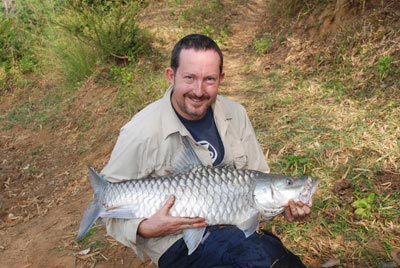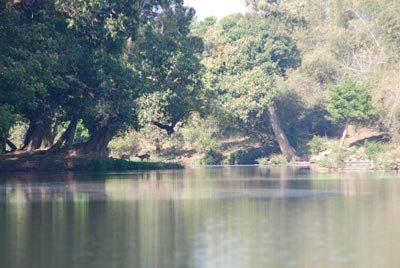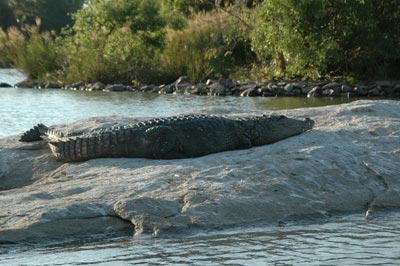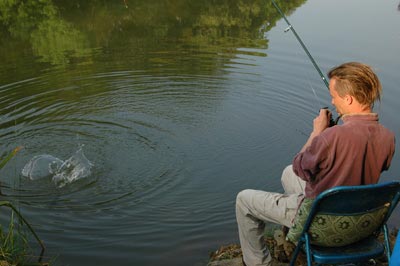The Hunt for Mahseer – Part 2
Introduction
AT THE END of Part 1, the sun was just rising over the jungle on another perfect Kaveri morning, and after many hours of poised silence Steve’s upstream rod was screaming in protest as something substantial furiously wrenched line from the spool…
Bait and Wait
In all the time I have travelled and fished with Steve I have rarely seen him ruffled or fazed by any situation, but from the moment he picked up and engaged the clutch he was clearly riding an emotional rollercoaster as the mighty mahseer ran him ragged for a frantic five minutes. Steve’s usually calm demeanour disappeared to be replaced by a myriad of ever-changing expressions and animations. He veered from complete terror to earnest concentration to absolute elation, and back again in the blink of an eye and the turn of a fin. With the initial fearsomely impressive runs and lunges successfully contained, he soon regained his composure and once he had skilfully guided the fish over the line-shredding mid-channel ridge, it was comparatively easy with the rod held low to the water to lead the beast towards the bank and the excited landing party.
  Steve’s Biggie |
Just as the biggie came looming up through the clear water with its golden scales glistening into the sunlight, Ganapathi, my long-lost twin (!) and one of the very knowledgeable and helpful local forest rangers joined us. He is veritable mine of information on the river and jungle, and especially mahseer. Steve’s fish was an absolute cracker; lean, powerful and a mouth you could fit a grapefruit in! We all agreed that she was comfortably a 20lber and the experienced Ganapathi suggested 10kg (22lb) was about right. After a quick picture and a rest in the margins she exploded back into life and back to the sacred depths of the Kaveri. We all decided to call it a day on the leger and rest the baited patch after such a brilliant result. With grins all round we invited Ganapathi and his colleague Yadav to join us for a hearty celebration breakfast.
Poachers and Eggs
As we sat together and enjoyed our masala omelette and chai (courtesy of Jim, our camp chef), we talked about our shared love of wildlife and our interest in conservation. Listening to their experiences and exhaustive knowledge of their patch was an absolute revelation. I was certainly jealous of their wild and beautiful home, but I did not envy their work combating the poaching which is rife in the region. We heard many gunshots during our regular night sessions and that terrible ‘death’ sound was a constant reminder that this is the front line in an ongoing war to preserve India’s rich and diverse wildlife.
  Wildlife at Croc Point |
The guys informed us that whilst they enjoyed the odd success, it was a constant battle against the odds. There were simply too few guards for such a massive area of dense forest, and they were outnumbered and outgunned by very determined criminal gangs. To make things worse the poachers are heavily armed and the rangers are only equipped with lathis (bamboo truncheons) against them. The mahseer are also the victims of indiscriminate killing, with dynamiting, poisoning and fixed-line fishing common occurrences along the watercourse. This problem is largely associated with the local population rather than organised poaching and it is hoped that education programmes amongst the villagers and tribal peoples will ease the situation.
Wildlife Worries
There was one piece of information that Ganapathi shared with us over breakfast that we probably could have done without hearing. A female tiger had recently moved into our area with two large cubs and in the previous few days she had crossed the river within yards of our concrete hut and taken a cow from the nearby village. Whilst we were obviously thrilled to hear that tigers were thriving in the region, this particular tale added an extra edge of nervous expectancy to our night fishing with every subsequent noise and stirring in the undergrowth now charged with toothy potential. Fortunately the tigers remained an unseen, shadowy presence during our trip but other large predators were rather more conspicuous.
  A Mugger Crocodile |
There was a healthy population of 10ft plus ‘mugger’ crocodiles on our stretch and many of the best places to fish were either cattle drinks where they like to ambush prey, or small islands where the crocs haul up to sunbathe. On many occasions at dawn we had seen chittal (Indian spotted deer) coming down to drink at a spot 70 yards upstream, where a spit of rock formed a calm bay. When I investigated ‘Croc Point’ with Ganapathi it was clear from the profusion of prints that many species visited regularly to quench their thirst including wild boar, deer and elephant. It was also a popular haunt for hungry reptiles, and there was a lot of crocodile dung. Ganapathi’s expert examination of undigested hairs revealed that these crocs had been taking prey as large as sambar (India’s biggest deer). From that point I always made sure I took my polarising sunglasses down to the river, whether I was fishing or just doing the washing-up, in case invisible eyes and smiling scaly jaws were regarding me as breakfast.
Waggler Magic
After our hearty feed we rowed out a bit more bait and then occupied ourselves with a completely different mahseer method. The waggler is a technique that is rarely associated with India’s premier fighting fish but I would certainly recommend it to anyone considering making a trip to the sub-continent. Sitting behind big baits on static rods will always catch the bigger specimens but for constant sport and enjoyment I would choose the waggler every time. Our stretch, we discovered, was absolutely stuffed full of small mahseer up to about 3lb and these mini-torpedoes provided consistently hair-raising action throughout the day. We didn’t have the conventional gear (can you get a travel waggler rod?) but improvised with a 12ft 2.75tc John Wilson Nomad carp rod coupled with one of Steve’s old and battered Abu fixed spools and 6lb mono straight through to a size 14 carp hook.
  The Waggler Technique |
We soon found that even this mish-mash of sturdy gear was only just up to the job. Small mahseer are both tenacious and turbocharged. We agreed between us that the fight ratio was approximately 1lb of mahseer to 5lb of common carp. There were no finicky bites; just electric wrap-arounds that bent the Wilson like a banana. We only had one waggler set-up between us but this wasn’t a problem. There were so many bites; we just swapped round every five fish! The bait was bread paste or flake and we fed small handfuls of mash every 5 minutes, or as needed on the rare occasions that bites dropped off. By 1-2pm it is far too hot for angling so we headed back to the hut for some welcome shade and a spot of bait preparation.
Know Your Quarry
Catching so many small mahseer was not only a lot of fun, it was also very useful for Steve’s ongoing project to determine which species of the fish are present in this part of the river. We spent a lot of time counting scales and fin rays, and taking taxonomic photos. One of the most curious features was the presence of a strange growth (mentum) under the chin of some fish. There is a lot of confusion surrounding mahseer identification and having inspected a large number of different specimens at first hand it is easy to see why. Gold, silver, black, bronze, green, blue-finned, it really is incredibly difficult to say which is which. And even these colourful descriptions are not necessarily indications that they are different species. After Jim and myself returned home, Steve was joined by fish specialist Dr. Mark Everard and they began a much more structured study. I’m hoping they will write up their findings, if they do I will post a link, as it should prove fascinating reading.
  A Taxonomic Photo |
A Nervy Night
On our next night behind the rods, everyone’s nerves were completely shot to pieces. Not because of our neighbourly tigers or friendly crocs but because we were overwhelmed by hours and hours of heart stopping line bites. These ranged in intensity from savage surges of line to tiny zips on the clutch, and kept us locked in a state of high alert. There was clearly a lot of fish moving over the bait but for some reason we were not connecting with them. As darkness slowly enveloped us we sat nervously on the edge of our seats very aware that one of us would make contact soon. And then, abruptly, everything went quiet. Not a peaceful quiet, but that kind of charged quiet you get when you ‘know’ that a big fish has moved in to your swim, and you ‘know’ you are about to experience the fight of your life. It was just a matter of time. We sat uneasily and waited, each of us praying that it would be our rod that would break the eerie stillness.
Conventional time is irrelevant when you are enveloped in such an anticipatory moment and I have no idea how long we sat there fidgeting before it finally happened…
Steve’s upstream rod tore off and this time he was poised and ready and on it in a flash. Jim and I rapidly reeled in as Steve was dragged down the bank with a blur of mono smoking from the reel. This monster was not going to stop and despite the rope-like qualities of 40lb Big Game, Steve couldn’t have set the clutch any tighter. If we had had time to think, we should have been in the coracle but it all happened so fast and seventy metres of line had flashed out before a terrible grating feeling juddered through his painfully arched rod, followed by that inevitable heartbreaking slackness of nothingness and loss.
The night fell silent again and this time we knew that it was a peaceful quiet and it was time to retire for the night. We were not disappointed. We had witnessed a display of power that is second to none in the fishing world, and we all have time. We returned to the hut, cracked open the Old Monk and contentedly planned future adventures…
NB: Request to my Fellow FM’ers
I have been asked by my host Bopanna not to mention the location of this little paradise, so if you do recognise the venue, please respect the wishes of local anglers, and do not mention its name on this or other forums. If you would like information on mahseer fishing in southern India please contact Bops directly through his forum (www.indianangler.com)
In part 3 of this mini-series I will collate all the advice and experience I have managed to accumulate and present a very basic beginners guide to tackle and techniques, along with a few useful travel tips for any intrepid fishermen who fancy visiting this amazing country.













